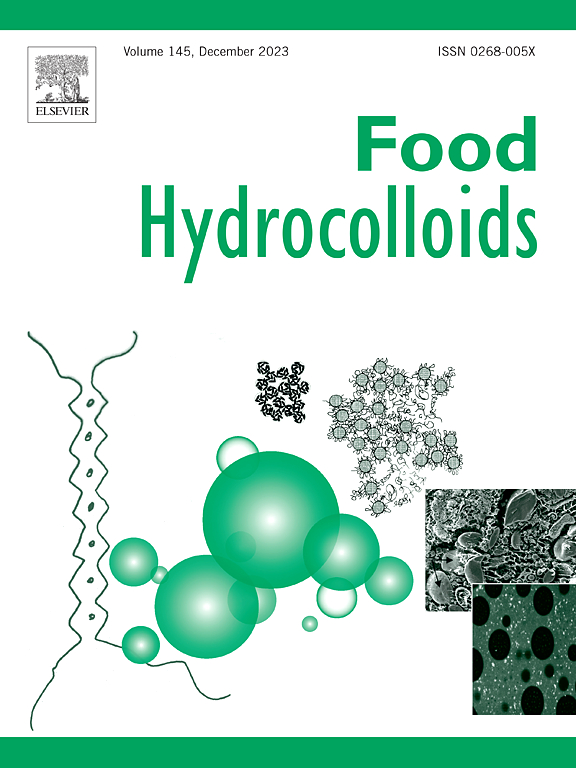大豆分离蛋白/γ-氨基丁酸复合物降低大豆球蛋白抗原:不同浓度的γ-氨基丁酸对蛋白质改性、抗原水平和发泡特性的影响
IF 11
1区 农林科学
Q1 CHEMISTRY, APPLIED
引用次数: 0
摘要
大豆粉因其独特的营养特性而受到越来越多的关注。然而,大豆蛋白的潜在过敏性限制了它的应用。本研究旨在探讨不同浓度的γ-氨基丁酸(GABA)对热灭菌大豆粉中大豆蛋白的二级结构、发泡特性和抗原性的影响。GABA 增加了大豆蛋白中 α-螺旋的含量,减少了 β-匝和无规线圈的含量。结果表明,加热处理后,GABA 的浓度会显著影响大豆分离蛋白(SPI)的空间构象。当 GABA 浓度为 0.40% (w/v) 时,SPI 的粒度、ZETA 电位和表面疏水性最低,而二硫键含量最高。多光谱技术表明,添加 0.40% 的 GABA 可以相对稳定地组装该系统。此外,蛋白质的刚性结构被破坏。这种结构变化大大降低了蛋白质的起泡性和过敏性。添加 0.40% GABA 可将β-共赖氨酸抗原浓度从 24.26 mg/mL 降至 4.43 mg/mL。这项研究为生产新型低过敏性大豆粉提供了新的见解。此外,它还为过敏症患者安全食用大豆提供了保证。本文章由计算机程序翻译,如有差异,请以英文原文为准。
Reduction of soybean globulin antigen by soybean protein isolate/γ-aminobutyric acid complexes: Effect of the different concentrations of γ-aminobutyric acid on the protein modification, antigen levels, and foaming properties
Soybean flour has received increasing attention because of its unique nutritional properties. However, potential allergies to soy protein limit its application. This study aims to investigate the impact of various concentrations of γ-aminobutyric acid (GABA) on the secondary structure, foaming properties, and antigenicity of soybean protein obtained from soybean flour under thermal sterilisation. GABA increased the content of α-helix, reduced β-turn and random coil in soybean protein. The results indicated that after heating treatment, the concentration of GABA significantly affects the spatial conformation of soybean protein isolates (SPI). When the concentration of GABA was 0.40% (w/v), the particle size, zeta potential, and surface hydrophobicity of the SPI were the lowest, whereas the disulfide bond content was the highest. Multi-spectral technologies indicated that adding 0.40% GABA could assemble the system in a relatively stable manner. Moreover, the rigid structure of the protein was destroyed. This structural change significantly reduced the foaming and allergy of the protein. Adding 0.40% GABA could reduce the β-conglycinin antigen concentration from 24.26 mg/mL to 4.43 mg/mL. This study provides new insights into the production of new low-allergenic soybean flour. Additionally, it offers an assurance for the safe consumption of soybeans by individuals with allergies.
求助全文
通过发布文献求助,成功后即可免费获取论文全文。
去求助
来源期刊

Food Hydrocolloids
工程技术-食品科技
CiteScore
19.90
自引率
14.00%
发文量
871
审稿时长
37 days
期刊介绍:
Food Hydrocolloids publishes original and innovative research focused on the characterization, functional properties, and applications of hydrocolloid materials used in food products. These hydrocolloids, defined as polysaccharides and proteins of commercial importance, are added to control aspects such as texture, stability, rheology, and sensory properties. The research's primary emphasis should be on the hydrocolloids themselves, with thorough descriptions of their source, nature, and physicochemical characteristics. Manuscripts are expected to clearly outline specific aims and objectives, include a fundamental discussion of research findings at the molecular level, and address the significance of the results. Studies on hydrocolloids in complex formulations should concentrate on their overall properties and mechanisms of action, while simple formulation development studies may not be considered for publication.
The main areas of interest are:
-Chemical and physicochemical characterisation
Thermal properties including glass transitions and conformational changes-
Rheological properties including viscosity, viscoelastic properties and gelation behaviour-
The influence on organoleptic properties-
Interfacial properties including stabilisation of dispersions, emulsions and foams-
Film forming properties with application to edible films and active packaging-
Encapsulation and controlled release of active compounds-
The influence on health including their role as dietary fibre-
Manipulation of hydrocolloid structure and functionality through chemical, biochemical and physical processes-
New hydrocolloids and hydrocolloid sources of commercial potential.
The Journal also publishes Review articles that provide an overview of the latest developments in topics of specific interest to researchers in this field of activity.
 求助内容:
求助内容: 应助结果提醒方式:
应助结果提醒方式:


